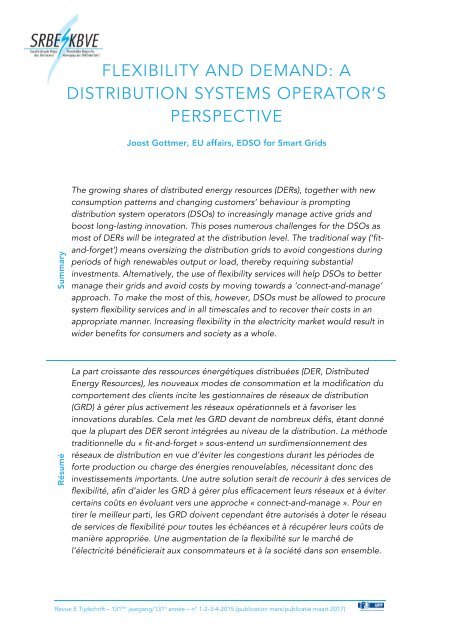RET_2015-01-02-03-04_Flipbook
You also want an ePaper? Increase the reach of your titles
YUMPU automatically turns print PDFs into web optimized ePapers that Google loves.
FLEXIBILITY AND DEMAND: A<br />
DISTRIBUTION SYSTEMS OPERATOR’S<br />
PERSPECTIVE<br />
Joost Gottmer, EU affairs, EDSO for Smart Grids<br />
Summary<br />
The growing shares of distributed energy resources (DERs), together with new<br />
consumption patterns and changing customers’ behaviour is prompting<br />
distribution system operators (DSOs) to increasingly manage active grids and<br />
boost long-lasting innovation. This poses numerous challenges for the DSOs as<br />
most of DERs will be integrated at the distribution level. The traditional way (‘fitand-forget’)<br />
means oversizing the distribution grids to avoid congestions during<br />
periods of high renewables output or load, thereby requiring substantial<br />
investments. Alternatively, the use of flexibility services will help DSOs to better<br />
manage their grids and avoid costs by moving towards a ‘connect-and-manage’<br />
approach. To make the most of this, however, DSOs must be allowed to procure<br />
system flexibility services and in all timescales and to recover their costs in an<br />
appropriate manner. Increasing flexibility in the electricity market would result in<br />
wider benefits for consumers and society as a whole.<br />
Résumé<br />
La part croissante des ressources énergétiques distribuées (DER, Distributed<br />
Energy Resources), les nouveaux modes de consommation et la modification du<br />
comportement des clients incite les gestionnaires de réseaux de distribution<br />
(GRD) à gérer plus activement les réseaux opérationnels et à favoriser les<br />
innovations durables. Cela met les GRD devant de nombreux défis, étant donné<br />
que la plupart des DER seront intégrées au niveau de la distribution. La méthode<br />
traditionnelle du « fit-and-forget » sous-entend un surdimensionnement des<br />
réseaux de distribution en vue d’éviter les congestions durant les périodes de<br />
forte production ou charge des énergies renouvelables, nécessitant donc des<br />
investissements importants. Une autre solution serait de recourir à des services de<br />
flexibilité, afin d’aider les GRD à gérer plus efficacement leurs réseaux et à éviter<br />
certains coûts en évoluant vers une approche « connect-and-manage ». Pour en<br />
tirer le meilleur parti, les GRD doivent cependant être autorisés à doter le réseau<br />
de services de flexibilité pour toutes les échéances et à récupérer leurs coûts de<br />
manière appropriée. Une augmentation de la flexibilité sur le marché de<br />
l’électricité bénéficierait aux consommateurs et à la société dans son ensemble.<br />
Revue E Tijdschrift – 131 ste jaargang/131 e année – n° 1-2-3-4-<strong>2<strong>01</strong>5</strong> (publication mars/publicatie maart 2<strong>01</strong>7)


